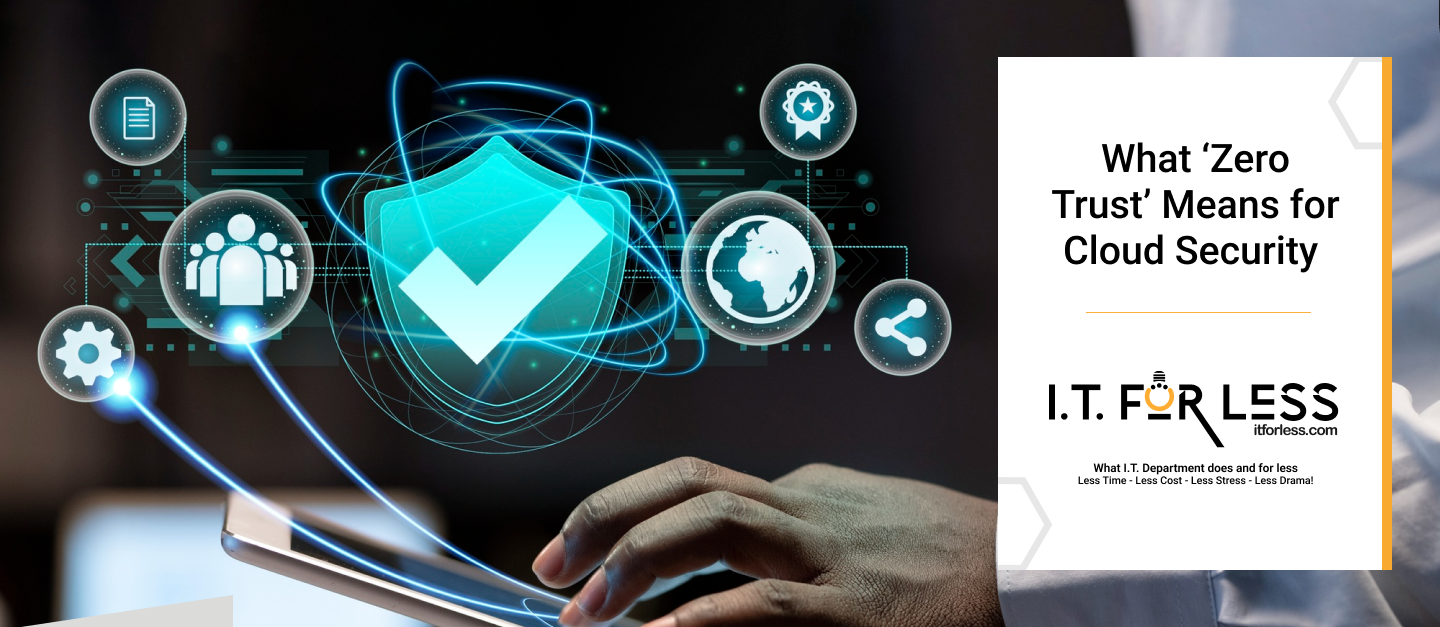In a world where remote work, cloud computing, and hybrid environments are the norm, traditional security models no longer cut it. The old assumption that everything inside your corporate firewall is safe? That’s outdated — and dangerous.
That’s where Zero Trust comes in.
As an MSP committed to securing businesses of all sizes, I.T. For Less is helping teams across industries understand and adopt Zero Trust for cloud environments. In this article, we’ll break down what Zero Trust means, why it matters for cloud security, and how small and mid-sized businesses can start building a Zero Trust strategy without blowing the budget.
What Is Zero Trust?
Zero Trust is a cybersecurity framework that assumes no user, device, or application should be trusted by default even if they’re inside the network perimeter.
Instead, everything must be verified before access is granted. The mantra is: “Never trust, always verify.”
This model flips the traditional castle-and-moat security paradigm. Rather than focusing on perimeter defense, Zero Trust puts strong access control, authentication, and continuous monitoring at the center.
Why Zero Trust Matters for Cloud Security
Cloud environments are inherently dynamic and decentralized, which makes them more difficult to protect using legacy security approaches.
Here’s why Zero Trust is essential for the cloud:
1. Users and Data Are Everywhere
Remote employees, contractors, and vendors connect from multiple locations and devices. Cloud apps are accessed over the internet, not just within your office network.
2. Perimeters No Longer Exist
In the cloud, there’s no single gateway to protect. Security must be enforced at every level: identity, device, network, and application.
3. Threats Are Constant and Sophisticated
Phishing, ransomware, credential stuffing, and insider threats are all on the rise and cloud environments are prime targets.
4. Compliance and Data Privacy Are Critical
Laws like HIPAA, GDPR, and CCPA require strict controls over who can access sensitive data and when.
Core Principles of Zero Trust in the Cloud
To implement Zero Trust effectively, especially in the cloud, businesses should focus on these key pillars:
1. Verify Explicitly
Always authenticate and authorize access based on multiple data points, including:
- User identity
- Device health
- Location
- Time of access
- Type of application or service
2. Enforce Least Privilege Access
Users should only have access to the data and systems they absolutely need. No more blanket admin rights.
Use:
- Role-Based Access Control (RBAC)
- Attribute-Based Access Control (ABAC)
- Just-in-Time (JIT) access for admins
3. Assume Breach
Design your system with the expectation that a breach has already happened or will happen soon.
This mindset leads to:
- Micro-segmentation of networks
- Continuous monitoring and logging
- Automated responses to suspicious activity
4. Continuous Monitoring and Real-Time Analytics
Security isn’t a one-and-done setup. It’s about continuously collecting and analyzing signals across your cloud infrastructure.
Use tools that:
- Detect anomalies in behavior
- Alert on unusual login patterns
- Correlate data across endpoints, identities, and cloud apps
Building a Zero Trust Strategy for Your Cloud Environment
Transitioning to Zero Trust doesn’t happen overnight and it doesn’t have to be overwhelming. Here’s how small and mid-sized businesses can get started:
Step 1: Inventory Your Cloud Assets and Access Points
Know what you have and who’s accessing it:
- SaaS apps (Google Workspace, Microsoft 365, Salesforce, etc.)
- IaaS environments (AWS, Azure, GCP)
- Users and their roles
- Devices (company-owned vs. personal)
Step 2: Enforce Strong Identity and Access Management (IAM)
This is your Zero Trust foundation:
- Enable Multi-Factor Authentication (MFA) everywhere
- Use Single Sign-On (SSO) with conditional access policies
- Implement strict user provisioning and offboarding
Step 3: Segment and Secure Your Cloud Workloads
Treat each cloud resource as its own mini-environment:
- Apply firewalls and access controls to VMs, containers, and databases
- Use private endpoints and VPCs (Virtual Private Clouds)
Step 4: Monitor Everything and Automate Response
Log everything. Then make it actionable.
- Use tools like Azure Sentinel, AWS GuardDuty, or third-party SIEMs
- Automate alerts and isolation of risky users or devices
Step 5: Educate Your Team
Zero Trust only works if your people understand the ‘why’ behind it.
- Train employees on phishing awareness, secure cloud behavior, and device hygiene
- Foster a culture of security across departments
Common Myths About Zero Trust (And the Truth)
Myth 1: Zero Trust is only for large enterprises. Truth: Small teams benefit even more — it reduces their attack surface dramatically with minimal overhead.
Myth 2: Zero Trust kills productivity. Truth: With smart policies (like SSO and adaptive MFA), you can improve security and user experience.
Myth 3: It’s too expensive or complex. Truth: With tools like Microsoft Defender for Business or Google Workspace’s security center, Zero Trust is more accessible than ever.
How I.T. For Less Makes Zero Trust Simple
At I.T. For Less, we specialize in helping growing businesses implement cloud security best practices — including Zero Trust — without unnecessary costs or complexity.
Here’s how we help:
- Zero Trust Readiness Assessment
- Cloud identity and access configuration
- MFA and SSO deployment
- Real-time monitoring setup
- Policy enforcement and access reviews
- Staff training and onboarding
Whether you use Google, Microsoft, AWS, or a combination, we tailor Zero Trust to fit your tools, your goals, and your budget.
Final Thoughts
Zero Trust isn’t a buzzword — it’s a mindset and a practical approach to modern cloud security. With threats growing more advanced and data more distributed, the need to verify every connection and protect every endpoint has never been greater.
You don’t need a massive IT budget to adopt Zero Trust. You just need the right plan — and the right partner.
Let I.T. For Less help you move toward a Zero Trust cloud model — one step at a time.
📧 Contact us | 📞 Schedule a Free Consultation | 🌐 www.itforless.com
